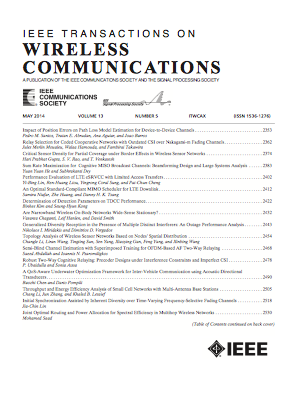Hemispherical Antenna Array Architecture for High-Altitude Platform Stations (HAPS) for Uniform Capacity Provision
IF 8.9
1区 计算机科学
Q1 ENGINEERING, ELECTRICAL & ELECTRONIC
引用次数: 0
Abstract
In this paper, we present a novel hemispherical antenna array (HAA) designed for high-altitude platform stations (HAPS). A significant limitation of traditional rectangular antenna arrays for HAPS is that their antenna elements are oriented downward, resulting in low gains for distant users. Cylindrical antenna arrays were introduced to mitigate this drawback; however, their antenna elements face the horizon leading to suboptimal gains for users located beneath the HAPS. To address these challenges, in this study, we introduce our HAA. An HAA’s antenna elements are strategically distributed across the surface of a hemisphere to ensure that each user is directly aligned with specific antenna elements. To maximize users’ minimum signal-to-interference-plus-noise ratio (SINR), we formulate an optimization problem. After performing analog beamforming, we introduce an antenna selection algorithm and show that this method achieves optimality when a substantial number of antenna elements are selected for each user. Additionally, we employ the bisection method to determine the optimal power allocation for each user. Our simulation results convincingly demonstrate that the proposed HAA outperforms the conventional arrays, and provides uniform rates across the entire coverage area. With a 20 MHz communication bandwidth, and a 50 dBm total power, the proposed approach reaches sum rates of 14 Gbps.用于高空平台站 (HAPS) 的半球形天线阵列架构,以提供统一容量
本文提出了一种用于高空台站的新型半球形天线阵列。用于HAPS的传统矩形天线阵列的一个显著限制是其天线单元向下定向,导致远程用户的增益较低。圆柱天线阵列的引入减轻了这一缺点;然而,它们的天线元件面对地平线,导致位于HAPS下方的用户获得不理想的增益。为了应对这些挑战,在本研究中,我们引入了我们的HAA。HAA的天线单元战略性地分布在半球表面,以确保每个用户直接与特定的天线单元对齐。为了最大化用户的最小信噪比(SINR),我们制定了一个优化问题。在进行模拟波束形成之后,我们介绍了一种天线选择算法,并表明当为每个用户选择大量天线单元时,该方法达到了最优性。此外,我们采用二分法来确定每个用户的最佳功率分配。我们的仿真结果令人信服地表明,所提出的HAA阵列优于传统的阵列,并在整个覆盖区域内提供均匀的速率。该方法的通信带宽为20mhz,总功率为50dbm,总速率为14gbps。
本文章由计算机程序翻译,如有差异,请以英文原文为准。
求助全文
约1分钟内获得全文
求助全文
来源期刊
CiteScore
18.60
自引率
10.60%
发文量
708
审稿时长
5.6 months
期刊介绍:
The IEEE Transactions on Wireless Communications is a prestigious publication that showcases cutting-edge advancements in wireless communications. It welcomes both theoretical and practical contributions in various areas. The scope of the Transactions encompasses a wide range of topics, including modulation and coding, detection and estimation, propagation and channel characterization, and diversity techniques. The journal also emphasizes the physical and link layer communication aspects of network architectures and protocols.
The journal is open to papers on specific topics or non-traditional topics related to specific application areas. This includes simulation tools and methodologies, orthogonal frequency division multiplexing, MIMO systems, and wireless over optical technologies.
Overall, the IEEE Transactions on Wireless Communications serves as a platform for high-quality manuscripts that push the boundaries of wireless communications and contribute to advancements in the field.

 求助内容:
求助内容: 应助结果提醒方式:
应助结果提醒方式:


